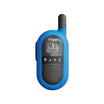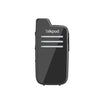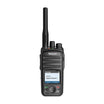Capacity
One of the main reasons businesses are switching to DMR is capacity. DMR allows you to at least double your capacity. DMR effectively splits out a single 12.5kHz channel into two – supporting two calls at the same time, independently.
This is called Time Division Multiple Access, where the communication paths are active for half the time, but at intervals so small that the difference is inaudible to users.
As the airwaves become more crowded, the old system which was built to handle just a few broadcasters, has started to ‘creak at the seams’. The ability, therefore, to split the spectrum, means that more people can communicate across a company’s licenced channel, without having to worry about interference.
Those channels work independently, so with two slots, you can carry two separate or private conversations, or you can use one slot for data or priority signalling, with the other reserved for conversation.
With DMR Tier III, capacity is further expanded with the ability for users to access different channels if others are occupied. User groups share a pool of channels, and any radio user can access any channel. The system’s control centre automatically allocates a channel from the pool, and if all channels are in use, call priority levels are taken into account. If a call is a higher priority than the other calls on the system, a lower priority call will be ‘kicked off’ to make room. If the call is the same or lower level priority as those taking place on the system, it will be placed in a queue to access the resource.
Infrastructure
Unlike TETRA, where transition would be a wholesale change in infrastructure, DMR allows you to take advantage of existing analogue infrastructure.
By infrastructure we are not referring to the radio equipment itself, but the supporting elements of the system – things like the antennas, antenna cabling, and combining equipment. Of course all of these command a significant amount of cost, so the ability to be able to re-use these is a significant advantage and an attractive proposition.
In the case of migration you are typically going to re-use the same frequencies. Tetra tends to be limited to only certain parts of a band depending on the country, and this is always UHF in Europe. A migration from analogue could be at VHF or UHF. Because the same frequencies that were used for analogue will be reused, then the same infrastructure like cabling, antennas and combining equipment can stay in place on a site.
Features
In addition to the two slot TDMA in Tier II, there are a number of extra features that are not present in analogue. For instance, DMR radios are significantly more energy efficient with approximately 40% longer battery life when compared with analogue. This is because, unlike analogue, the 2 slot TDMA DMR radio is only actually transmitting half the time (using 1 or 2 alternating slots). DMR radios can also have new voice and data services depending on the radio model chosen.
There is the potential for user-friendly private (one-to-one) calls. It is often far easier to use data applications such as GPS (for tracking) and telemetry (for handling alarms via your radios). DMR standards support the transmission of IP data over the air which makes standard applications easy to develop. And with location services, this makes DMR the logical choice for critical service industries.
Some features of digital are simply more user-friendly. For instance, with analogue it was possible to make individual and sub-group calls on certain legacy analogue systems but these often required the user to remember to press a series of buttons on their radio rather than work via a familiar mobile phone-like contact list (as in DMR).
Encryption is something that is far easier to adopt in a digital domain (after all we are already dealing with information that is a stream of 1s and 0s). It’s a matter of applying an encryption algorithm to this bit stream. With analogue there was significant processing required to achieve encryption. The resultant effect to radio users is the difference in coverage area. Analogue systems deploying encryption offer significantly reduced coverage range than an unencrypted one. Digital systems supporting encryption have minimal reduction in coverage over an unencrypted one, often no difference at all.
Quality
The greater your security requirement, the more important it is that your calls are clear and unbroken. The slightest chance of a misunderstanding can put lives at risk.
Analogue radio can suffer from certain limitations, which affect the quality of the transmission.
The environment itself can act as a limiter on sound quality, so any obstructions, while distance from the transmitter significantly decreases quality.
The difference with digital is that error correction is built in, ensuring the voice is clear throughout the coverage area, cancelling out static that is common in analogue, and many digital systems cancel out noise completely through the transmitter.
Efficiencies & improvements
When you decide to upgrade your network you most certainly do not want to simply replace it with what you already have.
Yes digital gives you advantages described above, but also digital makes it easier to integrate more features and functionality. Examples might be the addition of indoor location, asset tracking, work orders, and other applications that benefit your industry or business. A standardised development API can allow for the integration of other applications. The AIS is a DMR standardised protocol offered by Hytera to allow for integration to both our Tier 2 and Tier 3 offerings.
Additionally there are application developer’s kits for some of the Hytera Tier 2 and Tier 3 terminals that allow for integration to these.









































